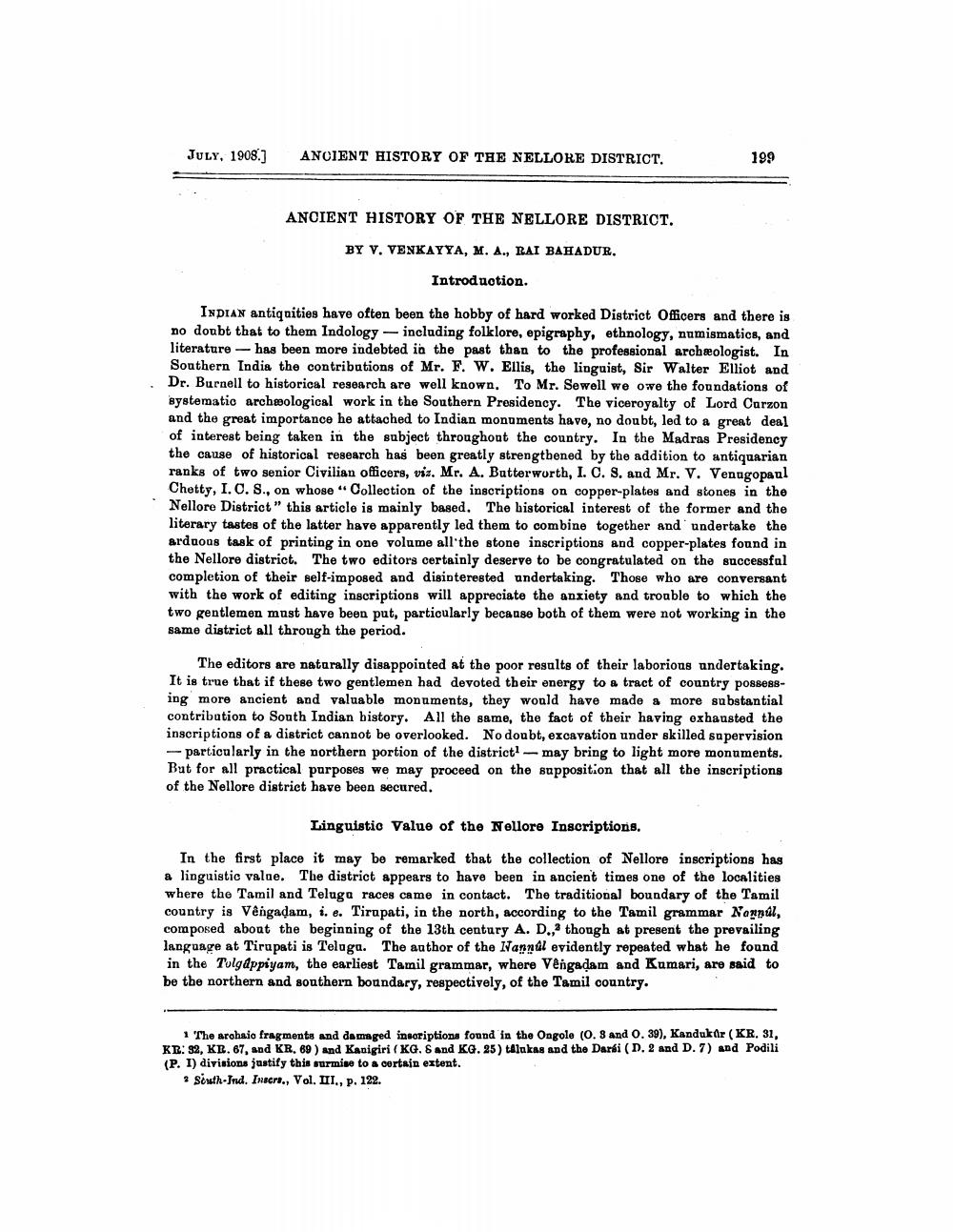________________
JULY, 1908.)
ANCIENT HISTORY OF THE NELLORE DISTRICT.
199
ANCIENT HISTORY OF THE NELLORE DISTRICT.
BY V. VENKAYYA, M. A., RAI BAHADUR.
Introduction.
INDIAN antiquities have often been the hobby of hard worked District Officers and there is no doubt that to them Indology - including folklore, epigraphy, ethnology, numismatics, and literature - has been more indebted in the past than to the professional archæologist. In Southern India the contributions of Mr. F. W. Ellis, the linguist, Sir Walter Elliot and Dr. Burnell to historical research are well known, To Mr. Sewell we owe the foundations of systematic archeological work in the Southern Presidency. The viceroyalty of Lord Carzon and the great importance he attached to Indian monuments have, no doubt, led to a great deal of interest being taken in the subject throughout the country. In the Madras Presidency the cause of historical research has been greatly strengthened by the addition to antiquarian ranks of two senior Civilian officers, viz. Mr. A. Butterworth, I. C. S. and Mr. V. Venugopaul Chetty, I.O.S., on whose Collection of the inscriptions on copper-plates and stones in the Nellore District" this article is mainly based. The historical interest of the former and the literary tastes of the latter have apparently led them to combine together and undertake the arduous task of printing in one volume all the stone inscriptions and copper-plates found in the Nellore district. The two editors certainly deserve to be congratulated on the successful completion of their self-imposed and disinterested undertaking. Those who are conversant with the work of editing inscriptions will appreciate the anxiety and trouble to which the two gentlemen must have been put, particularly because both of them were not working in the same district all through the period.
The editors are naturally disappointed at the poor regults of their laborious undertaking. It is true that if these two gentlemen had devoted their energy to a tract of country possessing more ancient and valuable monuments, they would have made a more substantial contribution to South Indian bistory. All the same, the fact of their having oxhausted the inscriptions of a district cannot be overlooked. No doubt, excavation under skilled supervision - particularly in the northern portion of the district1 - may bring to light more monuments. But for all practical purposes we may proceed on the supposition that all the inscriptions of the Nellore district have been secured.
Linguistio Value of the Nellore Inscriptions,
In the first place it may be remarked that the collection of Nellore inscriptions has a linguistic value. The district appears to have been in ancient times one of the localities where the Tamil and Teluga races came in contact. The traditional boundary of the Tamil country is Vengadam, i.e. Tirupati, in the north, according to the Tamil grammar Narpúl, composed about the beginning of the 13th century A. D., though at present the prevailing language at Tirupati is Telaga. The author of the Nanndl evidently repeated what he found in the Tulgappiyam, the earliest Tamil grammar, where Vengadam and Kumari, are said to be the northern and southern boundary, respectively, of the Tamil country.
1 The archaio fragments and damaged insoriptions found in the Ongolo (0.and . 39), Kandukar (KR. 31, KR:32, KR. 67, and KR. 69 ) and Kanigiri (KG, 6 and KG. 25) Alakas and the Darbi (D. 2 and D. 7) and Podili (P. I) divisions justify this surmise to a cortain extent.
Sirth-Ind. Inacrt., Vol. III., p. 122.




